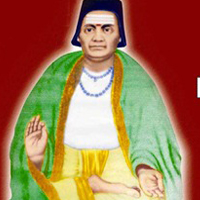Bhāskara
Bhāskara (commonly called Bhaskara I was a 7th-century mathematician and astronomer, who was the first to write numbers in the Hindu decimal system with a circle for the zero, and who gave a unique and remarkable rational approximation of the sine function in his commentary on Aryabhata’s work.This commentary, Āryabhaṭīyabhāṣya, written in 629 CE, is among the oldest known prose works in Sanskrit on mathematics and astronomy. He also wrote two astronomical works in the line of Aryabhata’s school, the Mahābhāskarīya and the Laghubhāskarīya.
Bhaskara I, (flourished c. 629, possibly Valabhi, near modern Bhavnagar, Saurashtra, India), Indian astronomer and mathematician who helped to disseminate the mathematical work of Aryabhata (born 476 AD).
Little is known about the life of Bhaskara- I appended his name to distinguish him from a 12th-century Indian astronomer of the same name. In his writings there are clues to possible locations for his life, such as Valabhi, the capital of the Maitraka dynasty, and Ashmaka, a town in Nizamabad of Telangana and the location of a school of followers of Aryabhata. His astronomical education was given by his father. Bhaskara is considered the most important scholar of Aryabhata’s astronomical school. He and Brahmagupta are two of the most renowned Indian mathematicians who made considerable contributions to the study of fractions. His fame rests on three treatises he composed on the works of Aryabhata. Two of these treatises, known today as Mahabhaskariya (“Great Book of Bhaskara”) and Laghubhaskariya (“Small Book of Bhaskara”), are astronomical works in verse, while Aryabhatiyabhashya (629) is a prose commentary on the Aryabhatiya of Aryabhata. Bhaskara’s works were particularly popular in South India.
Planetary longitudes, heliacal rising and setting of the planets, conjunctions among the planets and stars, solar and lunar eclipses, and the phases of the Moon are among the topics Bhaskara discusses in his astronomical treatises. He also includes a remarkably accurate approximation for the sine function: in modern notation, sin x = 4x(180 − x)/(40,500 − x(180 − x)), where x is in degrees which he assigns to Aryabhata. It reveals a relative error of less than 1.9% (the greatest deviation
{\displaystyle {\frac {16}{5\pi }}-1\approx 1.859\%}. Moreover, relations between sine and cosine, as well as between the sine of an angle >90° >180° or >270° to the sine of an angle <90° are given. Parts of Mahabhaskariya were later translated into Arabic.
In his commentary on the Aryabhatiya, Bhaskara explains in detail Aryabhata’s method of solving linear equations and provides a number of illustrative astronomical examples. Bhaskara particularly stressed the importance of proving mathematical rules rather than just relying on tradition or expediency. In supporting Aryabhata’s approximation to π, Bhaskara criticised the traditional use of Square root of
√10 for it (common among Jain mathematicians).
Bhaskara's probably most important mathematical contribution concerns the representation of numbers in a positional system. The first positional representations had been known to Indian astronomers approximately 500 years prior to this work. However, these numbers, prior to Bhaskara, were written not in figures but in words or allegories and were organized in verses. Quite remarkably, he often explains a number given in this system, using the formula ankair api ("in figures this reads"), by repeating it written with the first nine Brahmi numerals, using a small circle for the zero . Contrary to his word system, however, the figures are written in descending values from left to right, exactly as we do it today. Therefore, at least since 629, the decimal system is definitely known to the Indian scientists. Presumably, Bhaskara did not invent it, but he was the first having no compunctions to use the Brahmi numerals in a scientific contribution in Sanskrit.
Contributions of Bhaskara 1 in Mathematics
He worked with Number Zero.
The Sine function Approximate value was given by him.
Numbers in the Hindu Decimal System was written by Him.
He represented the numbers in a positional system.
Works of Aryabhatta was refined by him.
He and Brahmagupta have contributions to the study of fractions.
Bhaskara stated Pell equations even before Pell gave a name to it.
He was the first to use the Brahmi numerals in a scientific contribution to Sanskrit.
He even contributed in prime numbers.

Bhāskara
Date of Birth: 13 Nov 2025
Birth Place: 600 AD, Saurashtra,Gujarat
Proffession: mathematician and astronomer
Nationality: Indian
Death: 680 AD


